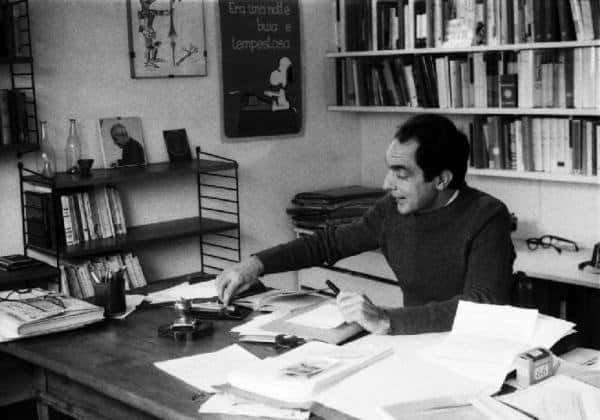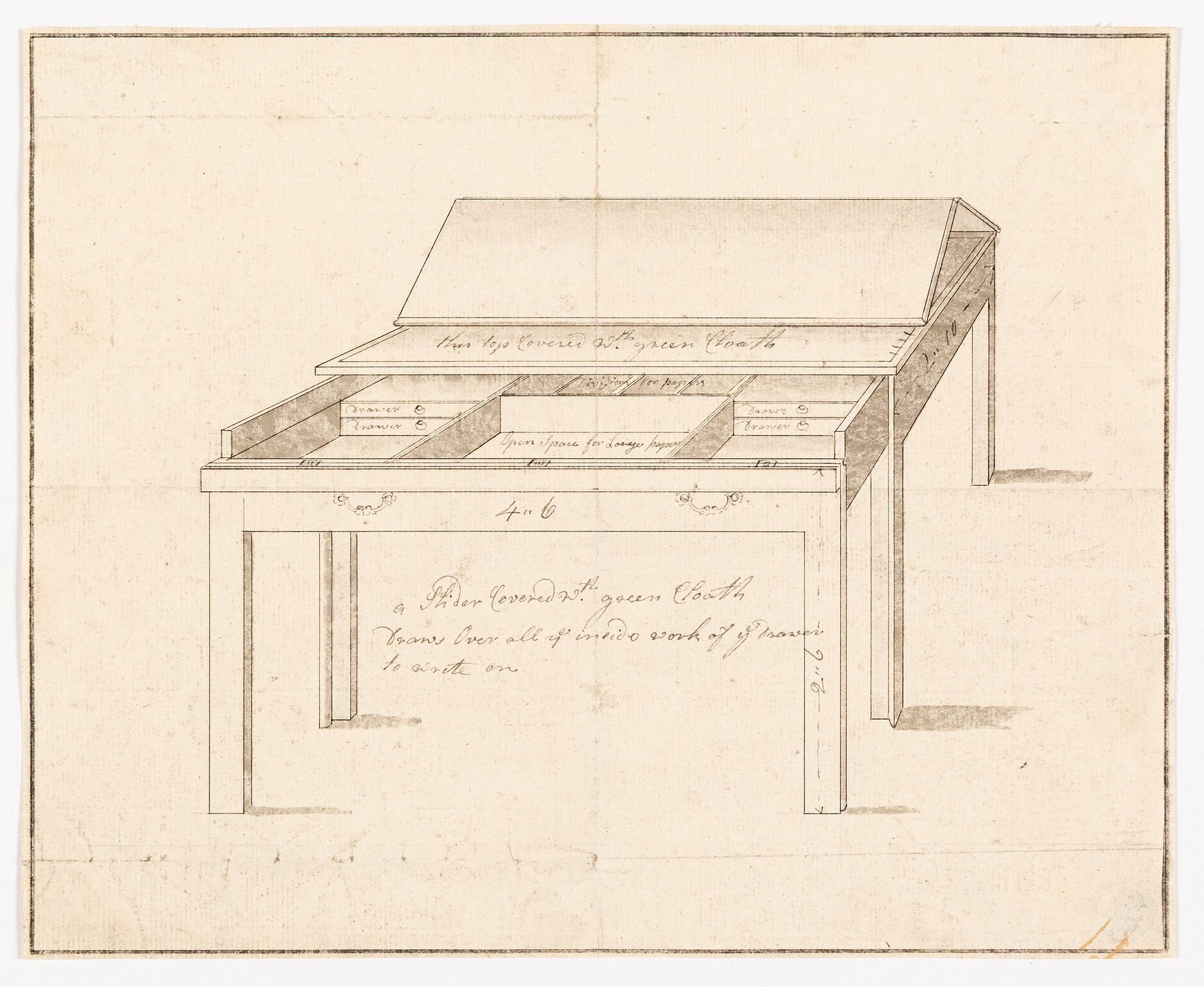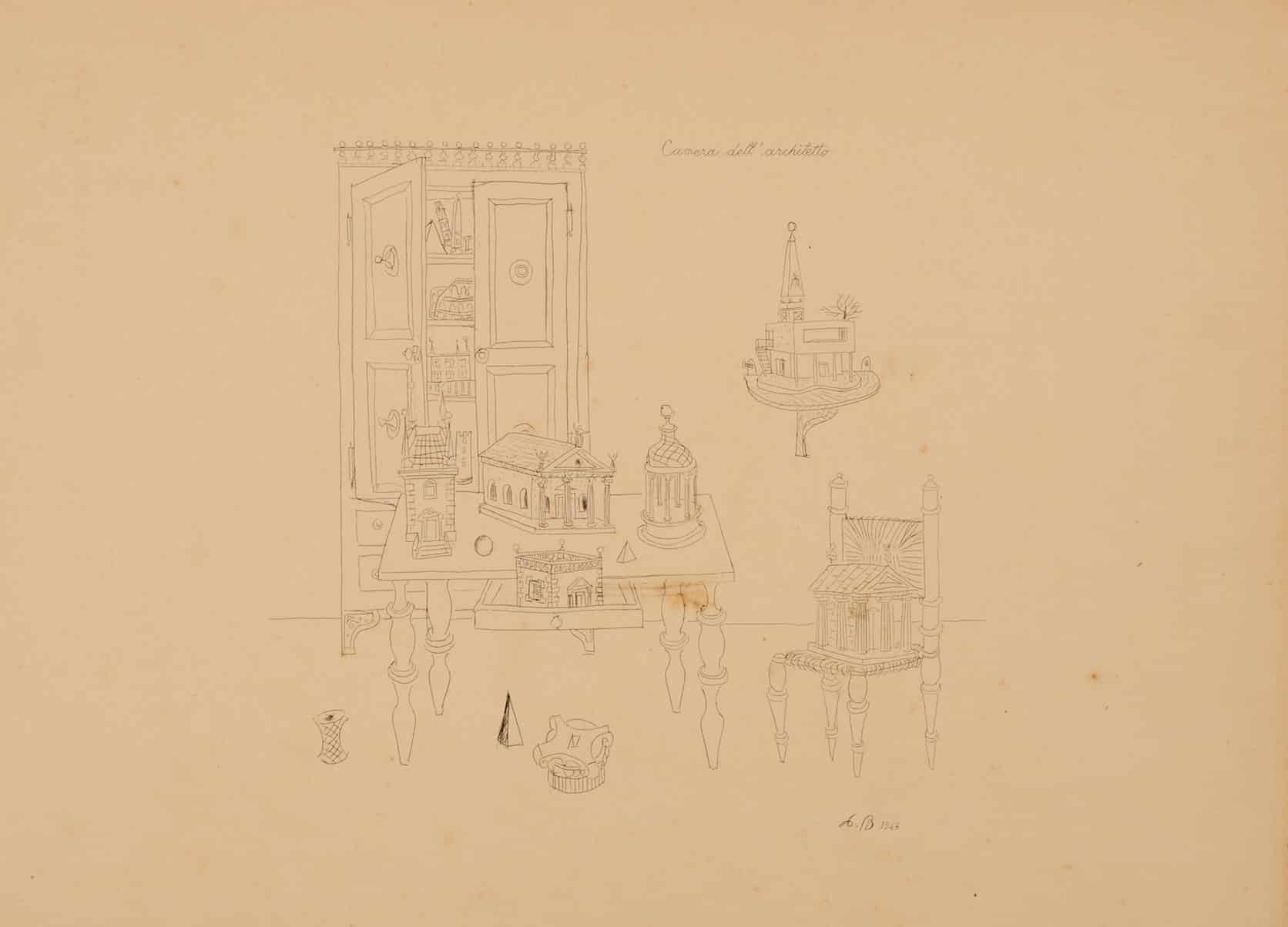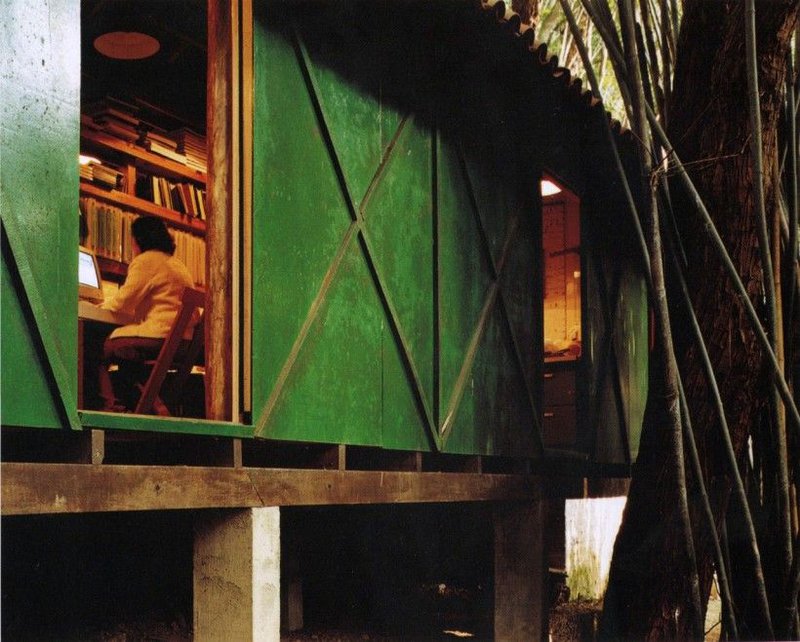Surface-oriented
My desk is a bit like an island: it could just as well be in some other country as here.
—Italo Calvino

The here in question is a narrow room occupying the top floor of a three-storey house on the southern fringe of Montparnasse. Heavily laden bookshelves and strategically placed objets extend along the length of one wall, framing the doorway. Where the shelves reach the ceiling a pitched roof slopes down to meet a line of south-facing windows and a door leading to a small roof terrace. The desk itself is a sturdy wooden affair positioned towards one end of the room. It can be approached from all sides, giving it the air of a dependable kitchen table that has been granted a second lease of life. A chair to one side orients the sitter towards the window with their back to the door. At the other end of the room is an informal seating area where a day bed and several armchairs are grouped around a low coffee table.
Despite its urban setting Calvino liked to refer to this residence as his ‘country home’, a place of solitude where he could conduct his work in isolation. This feeling arose from a sense that the cultural and literary image of Paris was so dense that it effectively ceased to exist as a potential subject in the imagination of the writer. It became ‘a city without a name’, at least in relation to his working life, which remained ‘entirely in Italy’. Tied up in this perception is the house atop which Île d’Italo was perched. When Calvino arrived in 1967 it was in the company of his wife Esther and their daughter Giovanna, then two years old. Paris was the backdrop against which ‘small practical problems of family life’ unfolded – perhaps a somewhat euphemistic way of describing the experience of sharing one’s home with a toddler. Esther worked as a translator for UNESCO and the young family employed a maid to keep the house ticking over. When they eventually returned to Italy in 1980 it was due in no small part to the loss of this employee, after which according to Esther ‘life became a catastrophe’.
If Paris was defined for Calvino during this period mostly by the fact of its not being Italy, then the conditions which allowed it to remain so in his mind were inextricably linked to the smooth management of his domestic affairs. ‘When I am in Paris you could say I never leave this study,’ he noted in 1974, suggesting a focus which radiated out from the desk to take in the rest of the room but not the rest of the house. Sara Ahmed has written that we orient ourselves ‘towards certain objects, those that help us find our way’. Using the example of Edmund Husserl’s description of his own desk, Ahmed notes how ‘the family home provides…the background against which an object (the writing table) appears in the present, in front of him’. Such an orientation is only made possible by ‘the work done to keep his desk clear, that is, the domestic work that might be necessary for Husserl to turn the table into a philosophical object’.

As anyone who works from home is well aware, balancing professional and domestic spheres can be a challenge. In a series of photos taken by Carla Cerati from the same year, we see a relaxed Calvino together with his family in the study – Giovanna hunched over the desk next to her father, or else squirming around on his knee as Esther looks on. Another image from this set shows Calvino seated alone behind the desk, a blank piece of paper laid out in front of him and his pen poised tantalisingly over an ink well, as if Cerati had tried to crystallise the precise moment that precedes an act of literary invention. But closer examination of the contact sheet shows Calvino interacting with someone outside the frame whilst Cerati works on the composition: perhaps Esther offering some direction on the staging or Giovanna chiming in with a question. Whether we can sustain an orientation towards the writing table, Ahmed concludes, is dependent on those forces which conspire to pull our attention away from it. All this is to say that the places where we choose to work, and by extension the surfaces we work on, are crucial insofar as they can help us find our way, whether by virtue of their orientation towards or away from the other spaces we inhabit.

But what if they aren’t up to the job? We do not know much about the provenance of this drawing, except that for a time it was attributed to Thomas Chippendale. Seemingly the author was so dissatisfied with their existing work surface that they decided to devote considerable energy towards reimagining it. A pair of swan-neck handles on the front panel would seem to situate the piece in the late eighteenth or early nineteenth century, and one of the annotations informs us that the desk was intended to be used for writing. A hinged top covered with green cloth conceals a hollow interior, accessible by sliding the front section of the desk forward. The author permits us to peer inside by choosing to represent the desk from above, its hinged lid neither fully open or closed. In this intermediate position the panels are reminiscent of a pitched roof; a change in scale which renders the various compartments within into a series of rooms that offer increasing privacy as they recede further into shadows beneath the eaves.
If you subscribe to the old adage that a tidy desk signals a tidy mind, then the author of this drawing must have harboured dreams of a spotless interior landscape. The internal compartment is annotated in a somewhat obstinate tone with diligently assigned labels for each of the four identical drawers. Further ‘divisions for papers’ bring much needed order to the veritable no man’s land of ‘open space for longer papers’, indicated towards the front. We are given no clues about the room where the desk is situated, nor can we tell if its internal compartments were ever put to use as intended, only that their number and arrangement points to a high regard for both prolificacy and order.

The author of the drawing may well have broken a sweat if confronted with this sketch by Lina Bo Bardi from 1943, titled Camera dell’architetto (Architect’s room). In the foreground a table is happily burping fully formed buildings, clown-car-like, from its one – one! – drawer. The surface is already so crowded that several others have been forced to decamp onto a nearby chair or the floor to make room. In the background an ornate armoire has been left open to reveal yet more buildings haphazardly stacked inside. Or perhaps its inhabitants opened the door themselves to get a look at the latest arrival: on the top shelf we can see what appears to be the Tower of Pisa peering round an obelisk in pursuit of a better view. The design of the furniture points towards a domestic interior – what I am naming as a desk could just as easily be a dressing table; the armoire a wardrobe. Indeed, the title does not give away what the function of this room might be, only that it is occupied by an architect. We don’t know whether the drawing was made before or after a bombing raid severely damaged Bo Bardi’s Milanese studio in August that year, but it’s not hard to imagine that the struggle to maintain a fledgling architectural practice during the war years might have left the young architect with a hard-headed attitude towards her own workspace. Any room will do, Bo Bardi seems to be proposing, so long as you have enough ideas to fill it.

Most of the buildings depicted are drawn from classical architecture with one noticeable exception: a modernist villa that sits elevated on its own private island away from the others. The upper branches of a tree are just visible behind the house – an early example of the ‘perfect correspondence’ between modern architecture and nature which came to define Bo Bardi’s architecture. Raised up above the others with an external staircase, narrow pilotis and a huge ribbon window, its design and setting are not dissimilar to the villa known as the Glass House, which Lina went on to build on a hillside overlooking São Paulo seven years later. There, a tree punched up through the middle of the house and expanded to a dense rainforest that enveloped the property over the following decades, today rendering it almost invisible from the road. When Bo Bardi added a separate studio to the grounds in 1986, she chose sliding wooden panels over windows so the sounds and smells of the surrounding trees could permeate the space.
‘I always stay half in the clouds, with just one foot in the city’, wrote Calvino. What Lina’s room and Italo’s island have in common is an understanding that where we happen to be is not always where we actually are, though the conditions which keep us firmly grounded in one place are very often the same ones that allow us to drift off somewhere else. The absent architect who occupies Bo Bardi’s room is able to shuttle back and forth from Ancient Rome simply by opening a cupboard door, whilst the owner of the writing table can conceal within its orderly divisions a personal archive far more reliable than the dusty drawers of memory will allow. Calvino’s desk, meanwhile, was positioned at the end of the study where the large picture window looking down onto the street gave way to a narrow horizontal aperture. When seated at his desk, the view through this pane would have been one of uninterrupted sky: the passing clouds could have just as easily been hovering above thirteenth century Venice as twentieth century Paris. Which, of course, they were.
Notes
Further reading
Sara Ahmed, ‘Orientations: Toward a Queer Phenomenology’, GLQ: A Journal of Lesbian and Gay Studies, vol 12, no 4 (Durham, NC: Duke University Press, 2006), pp 543–74.
Lina Bo Bardi, ‘Architecture and Nature: The House in the Landscape’, Domus 191, November 1943.
Italo Calvino, Hermit in Paris (London: Penguin, 1994).
Esther da Costa Meyer, ‘After the Flood’, Harvard Design Magazine 16, 2002.
Francine du Plessix Gray, ‘Visiting Italo Calvino’, The New York Times, June 21 1981.
Damien Pettigrew and William Weaver, ‘Italo Calvino, The Art of Fiction No 130’, The Paris Review 124, 1992.
